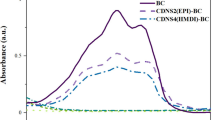Abstract
An amphiphilic biodegradable three-arm star-shaped diblock copolymer containing poly(ε-caprolactone) (PCL) and poly(N-vinylpyrrolidone) (PVP) (TEA(PCL-b-PVP)3) has been successfully synthesized by the ring-opening polymerization of ε-caprolactone (ε-CL), RAFT polymerization of N-vinylpyrrolidone and a coupling reaction of PCL with carboxyl-terminated PVP (PVP-COOH). In aqueous media, the star-shaped copolymer self-assembled into spherical micelles with diameters of near 106 nm. The critical micelle concentration of TEA(PCL-b-PVP)3 copolymer was determined to be 5.96 × 10−3 mg/mL. Folic acid was then used as a model drug to incorporate into TEA(PCL-b-PVP)3 micelles, the drug loading content and encapsulation efficiency is 16.36 and 49.08 %, respectively. In vitro release experiments of the drug-loaded micelles exhibited sustained release behavior and it was affected by the pH of release media. These results indicate that the copolymer may serve as a promising “intelligent” drug delivery alternative.







Similar content being viewed by others
References
Xiong XB, Uludag H, Lavasanifar A (2009) Biodegradable amphiphilic poly(ethylene oxide)-block-polyesters with grafted polyamines as supramolecular nanocarriers for efficient siRNA delivery. Biomaterials 30:242–253
Wang F, Bronich TK, Kabanov AV, Rauh RD, Roovers J (2005) Synthesis and evaluation of a star amphiphilic block copolymer from poly(ε-caprolactone) and poly(ethylene glycol) as a potential drug delivery carrier. Bioconjug Chem 16:397–405
Jiang G, Xu H (2010) Synthesis and evaluation of a star amphiphilic block copolymer from poly(ε-caprolactone) and poly(ethylene oxide) as load and release carriers for guest molecules. J Appl Polym Sci 118:1372–1379
Xiang L, Shen LJ, Long F, Yang K, Fan JB, Li YJ, Xiang JN, Zhu MQ (2011) A convenient method for the synthesis of the amphiphilic triblock copolymer poly(l-lactic acid)-block-poly(l-lysine)-block-poly(ethylene glycol) monomethyl ether. Macromol Chem Phys 212:563–573
Jain JP, Ayen WY, Kumar N (2011) Self assembling polymers as polymersomes for drug delivery. Curr Pharm Des 17:65–79
Yu LQ, Zhou LJ, Ding MM, Li JH, Tan H, Fu Q, He XL (2011) Synthesis and characterization of novel biodegradable folate conjugated polyurethanes. J Colloid Interf Sci 358:376–383
Hu XL, Jing XB (2009) Biodegradable amphiphilic polymer-drug conjugate micelles. Expert Opin Drug Del 6:1079–1090
Xing ZM, Yang GS (2010) Crystallization, melting behavior, and wettability of poly(e-caprolactone) and poly(ε-caprolactone)/poly(N-vinylpyrrolidone) blends. J Appl Polym Sci 115:2747–2755
Hu Y, Jiang ZP, Chen R, Wu W, Jiang XQ (2010) Degradation and degradation-induced re-assembly of PVP-PCL micelles. Biomacromolecules 11:481–488
Zhu ZS, Li Y, Li XL, Li RT, Jia ZJ, Liu BR, Guo WH, Wu W, Jiang XQ (2010) Paclitaxel-loaded poly(N-vinylpyrrolidone)-b-poly(ε-caprolactone) nanoparticles: preparation and antitumor activity in vivo. J Controlled Release 142:438–446
Jones DS, Djokic J, McCoy CP, Gorman SP (2002) Poly(ε-caprolactone) and poly(ε-caprolactone)-polyvinylpyrrolidone-iodine blends as ureteral biomaterials: characterisation of mechanical and surface properties, degradation and resistance to encrustation in vitro. Biomaterials 23:4449–4458
Suganya S, Ram TS, Lakshmi BS, Giridev VR (2011) Herbal drug incorporated antibacterial nanofibrous mat fabricated by electrospinning: an excellent matrix for wound dressings. J Appl Polym Sci 21:2893–2899
Chung TW, Cho KY, Lee HC, Nah JW, Yeo JH, Akaike T, Cho CS (2004) Novel micelle-forming block copolymer composed of poly (ε-caprolactone) and poly(vinyl pyrrolidone). Polymer 45:1591–1597
Jeon HJ, You YC, Youk JH (2009) Synthesis and characterization of amphiphilic poly(N-vinyl pyrrolidone)-b-poly(ε-caprolactone) copolymers by a combination of cobalt-mediated radical polymerization and ring-opening polymerization. J Polym Sci, Part A: Polym Chem 47:3078–3085
Mishra AK, Patel VK, Vishwakarma NK, Biswas CS, Raula M, Misra A, Mandal TK, Ray B (2011) Synthesis of well-defined amphiphilic poly(ε-caprolactone)-b-poly-(N-vinylpyrrolidone) block copolymers via the combination of ROP and xanthate-mediated RAFT polymerization. Macromolecules 44:2465–2473
Lele BS, Leroux JC (2002) Synthesis and micellar characterization of novel amphiphilic A-B-A triblock copolymers of N-(2-hydroxypropyl)methacrylamide or N-vinyl-2-pyrrolidone with poly(ε-caprolactone). Macromolecules 35:6714–6723
Leiva A, Quina FH, Araneda E, Gargallo L, Radić D (2007) New three-arm amphiphilic and biodegradable block copolymers composed of poly(ε-caprolactone) and poly(N-vinyl-2-pyrrolidone). Synthesis, characterization and self-assembly in aqueous solution. J Colloid Interf Sci 310:136–143
Ananthapadmanabhan KP, Goddard ED, Turro NJ, Kuo PL (1985) Fluorescence probes for critical micelle concentration. Langmuir 1:352–355
Shin IG, Kim SY, Lee YM, Cho CS, Sung YK (1998) Methoxy poly(ethylene glycol)/ε-caprolactone amphiphilic block copolymeric micelle containing indomethacin: I. Preparation and characterization. J Controlled Release 51:1–11
Kim SY, Lee YM (2001) Taxol-loaded block copolymer nanospheres composed of methoxy poly(ethylene glycol) and poly(ε-caprolactone) as novel anticancer drug carriers. Biomaterials 22:1697–1704
Seow WY, Xue JM, Yang YY (2007) Targeted and intracellular delivery of paclitaxel using multi-functional polymeric micelles. Biomaterials 28:730–1740
Luo YL, Yao XJ, Yuan JF, Ding T, Gao QY (2009) Preparation and drug controlled-release of polyion complex micelles as drug delivery systems. Colloid Surface B: Biointerfaces 68:218–224
Nagayasu A, Uchiyama K, Kiwada H (1999) The size of liposomes: a factor which affects their targeting efficiency to tumors and therapeutic activity of liposomal antitumor drugs. Adv Drug Deliv Rev 40:75–87
Schmaljohann D (2006) Thermo- and pH-responsive polymers in drug delivery. Adv Drug Deliv Rev 58:1655–1670
Author information
Authors and Affiliations
Corresponding author
Rights and permissions
About this article
Cite this article
Zhai, C., Liu, X., Yuan, J. et al. Synthesis, characterization, and drug delivery research of an amphiphilic biodegradable star-shaped block copolymer. Polym. Bull. 70, 419–429 (2013). https://doi.org/10.1007/s00289-012-0800-4
Received:
Revised:
Accepted:
Published:
Issue Date:
DOI: https://doi.org/10.1007/s00289-012-0800-4




